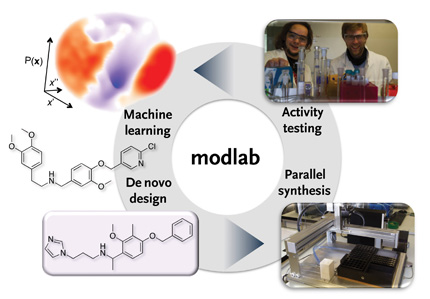In Silico Chemogenomics Knowledgebase and Computational System Neuropharmacology Approach for Cannabinoid Drug Research. In General Processes and Mechanisms, Prescription Medications, Caffeine and Areca, Polydrug Misuse, Emerging Addictions and NonDrug Addictions. cations of computational chemogenomics have applied the concept to discover ligands for simulated orphan targets [36 (Class III prediction) as well as study resistance development through point mutations in HIV nonnucleoside reverse transcriptase mutants[37. Computational Chemogenomics Methods In Molecular Biology Ebook Computational Chemogenomics Methods In Molecular Biology currently available at sinp. The Computational Chemogenomics Core for Drug Abuse (CC4DA, or Core A) of CDAR, is proposed specifically to address existing fundamental challenges of drug abuse (DA) and medication research to enhance the NIHNIDA funded research projects. Chemogenomics matches target space with ligand space, and vice versa. The underlying assumption of this field are: i) Molecules with enough similarity to ligands for which a target profile is known have a high probability of sharing the same target; ii) Targets sharing similar ligands should have. Computational chemistry journals may be a branch of chemistry that uses framework to help in determination chemical issues. It uses strategies of theoretical chemistry journals, incorporated into economical laptop programs, to calculate the structures and properties of molecules and solids. The strategies used cowl each static and dynamic things. Computational chemogenomics (or proteochemometric modeling) is an integral part of the molecular informatics toolbox and represents a consequent coalescence of the ligand and receptorbased philosophies. Computational chemogenomic models leverage the information available by comparing the similarities of both ligands and targets simultaneously. Download Computational Chemogenomics or any other file from Books category. HTTP download also available at fast speeds. Few studies have focused on fatigue in myasthenia gravis (MG), and fatigue in relation to the autonomic system has never been systematically explored in these patients. Moreover, computational concepts to systematically analyze and predict ligandtarget interactions, often more narrowly defined as chemogenomics modeling (vide supra), are highly relevant. To these ends, a variety of machine learning approaches are applied, also including methods that have become en vogue recently, such as active learning and. However, computational chemogenomics (CG) has demonstrated benefits of learning from entire grids of data at once, rather than building targetspecific QSARs. A possible reason for this is the emergence of inductive knowledge transfer (IT) between targets, providing statistical robustness to the model, with no assumption about the structure of. Activity Using Computational Chemogenomics Technology James Hendrix, Ph. Standard Approach to Drug Discovery Pick a disease Pick a Target Screen for Compounds! nPharmakon: IndicationAgnostic Approach Computational chemogenomics is expected to increase the quality and productivity of drug discovery and lead to the discovery of new medicines. Organization: CRC Press Please confirm that you would like to log out of Medscape. If you log out, you will be required to enter your username and password the next time you visit. Chemogenomics, or chemical genomics, is the systematic screening of targeted chemical libraries of small molecules against individual drug target families (e. , GPCRs, nuclear receptors, kinases, proteases, etc. ) with the ultimate goal of identification of novel drugs and drug targets. Chemogenomics is defined, in principle, as the screening of the chemical universe (i. , all possible chemical compounds) against the target universe (i. This book provides a collection of techniques used in the emerging field of computational chemogenomics, an integration of chemoinformatics, bioinformatics, computer science, statistics, automated pattern recognition and modeling, database usage. Department of Life Science Informatics, BIT, LIMES Program Unit Chemical Biology and Medicinal Chemistry, Rheinische Bonn, Dahlmannstr. Computational chemogenomics is expected to increase the quality and productivity of drug discovery and lead to the discovery of new medicines. Read more Read less See the Best Books of the Month Computational chemogenomics is expected to increase the quality and productivity of drug discovery and lead to the discovery of new medicines. Students and academics in chemistry, bioinformatics and pharmaceutical sciences Chemogenomics is a new interdisciplinary research field aiming at the genomewide systematic identification, expansion, analysis, and prediction of ligandprotein interactions using both in vitro and in silico approaches. Computational target fishing is naturally collaborative work as it links the cheminformatists, chemists, biologists and pharmaceutical scientists by the computational approaches, compounds, biology activity and drugs, respectively, to speed up drug discovery. Computational genomics (often referred to as Computational Genetics) refers to the use of computational and statistical analysis to decipher biology from genome sequences and related data. Chemogenomics is a new interdisciplinary research field aiming at the genomewide systematic identification, expansion, analysis, and prediction of ligandprotein interactions using both in vitro and in silico approaches. Computational chemogenomics integrates the aspects of chemoinformatics and bioinformatics and aims to provide adequate molecular information systems for chemogenomics data. We are pleased to announce the Workshop entitled Computational Chemogenomics to understand System Biology and Computational Medicinal Chemistry taking place at the University of Geneva on May 1416, 2012. The Workshop, organized and chaired by William H. Bisson and Leonardo Scapozza, will have the privilege of having internationally recognized speakers and leaders attending from both. Chemogenomics is a new interdisciplinary research field aiming at the genomewide systematic identification, expansion, analysis, and prediction of ligandprotein interactions using both in. The stateoftheart computational technologies together with the chemogenomics database enable us to understand the DA in systems pharmacology level, for example, predicting the possible interactions with all the human proteins. Computational chemogenomics is expected to increase the quality and productivity of drug discovery and lead to the discovery of new medicines. We provide complimentary einspection copies of primary textbooks to instructors considering our books for course adoption. The conference objective is to exchange ideas across discipline boundaries of computational chemistry, chemoinformatics, chemogenomics, including latest advances in computational approaches to drug discovery innovation. The conference aims to bring together industrialists, researches, educators and students interested in computational methods and to assess and publicize the latest. Computational Biology and Chemogenomics Team. Dr Bissan AlLazikanis t eam develops computational tools to help cancer drug discovery efforts process the large amounts of data obtained through biomedical research. Background: Chemical biology and chemogenomics are rapidly evolving disciplines at interfaces between chemistry and the life sciences and are highly interdisciplinary in nature. Chemogenomics has a strong conceptional link to modern drug discovery research, whereas chemical biology focuses more on the use of small molecules as probes for exploring biological functions, rather than drug candidates. The National Center of Excellence for Computational Drug Abuse Research (CDAR), is a joint initiative between the University of Pittsburgh (Pitt) and Carnegie Mellon University (CMU), funded by the NIH (NIDA). to advance and implement stateoftheart computational chemical genomics (chemogenomics) technologies for facilitating d rug a buse. WorldCat Home About WorldCat Help. Search for Library Items Search for Lists Search for Contacts Search for a Library. Create lists, bibliographies and reviews: or Search WorldCat. Find items in libraries near you. A Perspective on Computational Chemogenomics A Perspective on Computational Chemogenomics Bajorath, Jrgen 00: 00: 00 It seems like only yesterday that chemogenomics has appeared on the scene. For already more than a decade, chemogenomics has been a much discussed concept at the interface between (medicinal) chemistry and biology. Keywords: big data, chemogenomics, cloud computation, computational target fishing, information integration Target fishing, or target identification, is an important start step in modern drug development, which investigates the mechanism of action of bioactive small molecules by. Computational chemogenomics is expected to increase the quality and productivity of drug discovery and lead to the discovery of new medicines. Read more Read less click to open popover [P45 Computational chemogenomics is it more than inductive transfer? Brown 1, Yasushi Okuno, Gilles Marcou2, Alexandre Varnek2, Dragos Horvath2 1 Kyoto University Graduate School of Pharmaceutical Sciences, Department of Systems However, computational chemogenomics (CG) has demonstrated benets of learning from entire grids of data at once, rather than building targetspecic QSARs. A pos This book focuses on applications of compound library design and virtual screening to expand the bioactive chemical space, to target hopping of chemotypes to identify synergies within related drug discovery projects or to repurpose known drugs, to Computational Chemical Genomics Screening Center (CCGS) is a researchteaching and collaboration platform providing new exploratory computational toolsalgorithms and chemical libraries resources in a chemical genomics scale for insilico drug design and discovery. Computational chemogenomics focuses on new in silico applications, such as compound library design and virtual screening, to expand the bioactive chemical space, target hopping of chemotypes to identify synergies within related drug discovery projects, or to repurpose known drugs, elucidation of the mechanism of action of compounds, or identi. Computational chemogenomics Computational chemogenomics Jacoby, Edgar 00: 00: 00 Chemogenomics is a new interdisciplinary research field aiming at the genomewide systematic identification, expansion, analysis, and prediction of ligandprotein interactions using both in vitro and in silico approaches. Computational chemogenomics integrates the aspects of chemoinformatics and. [Edgar Jacoby; This book focuses on applications of compound library design and virtual screening to expand the bioactive chemical space, to target hopping of chemotypes to identify synergies within related drug.











